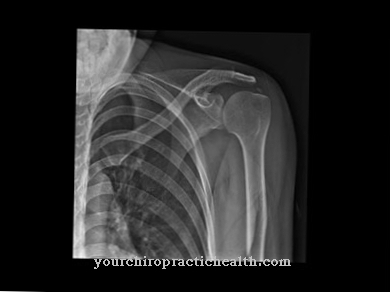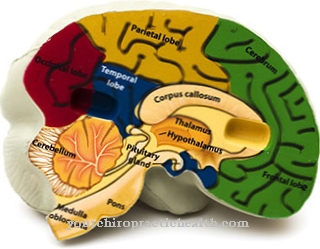The Dandy Walker Syndrome is a congenital developmental disorder with various courses. Especially with early diagnosis, the syndrome is currently not curable, but symptomatically treatable.
What is Dandy Walker Syndrome?

© Sondem - stock.adobe.com
Dandy Walker Syndrome is a developmental disorder of the brain that is congenital. Occasionally, the terms Dandy-Walker complex or Dandy-Walker cyst are used for Dandy-Walker syndrome.
The syndrome is named after the neurosurgeon Dandy and the neurologist Walker, who first described and defined the disease. Dandy Walker Syndrome is usually characterized by the fact that those affected have a malformation of the cerebellum (a part of the brain that is responsible, among other things, for controlling movements or coordination):
The connection between the two halves of the cerebellum that exists in healthy people is either underdeveloped or non-existent. In addition, the Dandy Walker Syndrome usually shows an expansion of the so-called 4th cerebral water chamber of the brain. Here there is a possible accumulation of brain water, which can cause a so-called water head in infants and small children. Most of the children affected by Dandy Walker Syndrome develop such a water head.
causes
The causes that lead to the developmental disorder Dandy Walker Syndrome in individual cases cannot often be clearly understood.
However, both hereditary and non-hereditary influencing factors are possible. Hereditary (genetic) causes of Dandy Walker Syndrome can be found in other hereditary diseases transmitted to a newborn, which cause the malformations that can be observed in Dandy Walker Syndrome.
Non-hereditary causes for the presence of Dandy Walker Syndrome in a newborn baby include, for example, factors such as the presence of a rubella infection in the mother during pregnancy or the consumption of alcohol by the mother during the pregnancy.
Symptoms, ailments & signs
Dandy Walker Syndrome is associated with a number of different complaints that can make life and everyday life much more difficult for those affected. First and foremost, the syndrome leads to significant disturbances in child development, so that most patients also suffer from symptoms of the syndrome in adulthood.
The head of the person concerned is significantly enlarged, so that there may be aesthetic restrictions that have a very negative effect on the patient's self-esteem. This often leads to bullying or teasing, especially with children. Furthermore, due to the Dandy Walker Syndrome, the patients also suffer from severe headaches, nausea and vomiting, whereby these complaints usually occur for no apparent reason.
Disturbances of consciousness can also occur, whereby the person affected completely loses his consciousness and can possibly injure himself if he falls. The syndrome is also accompanied by severe visual disturbances, which can, however, be compensated for by using visual aids. In some cases, patients experience cramps that can appear in different parts of the body and on different muscles.
The quality of life of the person affected is considerably restricted and reduced by the syndrome. The relatives or parents often suffer from severe psychological moods or from depression.
Diagnosis & course
Dandy Walker Syndrome can be diagnosed in newborns a short time after birth. This is usually done with the help of an ultrasound scan if there is a suspicion. The diagnosis of Dandy Walker Syndrome can be confirmed by the methods of magnetic resonance imaging (MRT) or computed tomography (CT).
The course of the developmental disorder Dandy Walker Syndrome depends, among other things, on the severity of the disorder in the individual case. While Dandy Walker Syndrome can take very severe courses, it occasionally remains undetected for long periods of time. A head of water in the context of Dandy Walker Syndrome can lead to increased intracranial pressure in older children; this manifests itself, for example, in nausea, headache or visual disturbances.
In the course of Dandy Walker Syndrome, mental development is often impaired. As a rule, the earlier the disease is discovered and treated, the better the prognosis for Dandy Walker syndrome.
When should you go to the doctor?
As a rule, Dandy Walker Syndrome is a congenital complaint, so that an additional diagnosis does not have to be made in most cases. However, a doctor should be consulted at an early stage, as early treatment can significantly reduce most complications and symptoms.
Parents should then see a doctor with their child if Dandy Walker Syndrome causes developmental disorders. High intracranial pressure or constant headaches can also indicate the disease and should therefore be examined.
The syndrome can also lead to visual disturbances or nausea and vomiting, so that a medical examination is necessary for these symptoms too. Most of the children also suffer from cramps. The diagnosis of Dandy Walker Syndrome is usually made by a general practitioner. Further treatment is carried out by the respective specialists so that all complaints are limited. The earlier the disease is diagnosed, the higher the chances of a complete cure for Dandy Walker Syndrome.
Doctors & therapists in your area
Treatment & Therapy
Dandy Walker Syndrome cannot be cured according to the current medical status. However, there are various therapy methods available to manage the symptoms that may be associated with Dandy Walker Syndrome.
As a rule, children with Dandy Walker Syndrome undergo regular medical examinations. For example, increased intracranial pressure can be detected at an early stage, which can develop due to the accumulation of cerebral fluid in the 4th cerebral water chamber. If such increased intracranial pressure is found in a child affected by Dandy Walker Syndrome, the cerebral fluid can be drained off with the help of a tube in one treatment step. Such an intervention is carried out by a trained specialist.
If the Dandy Walker Syndrome affects a person's balance, this can often be positively influenced by targeted physiotherapeutic (physiotherapy) measures. Seizures, which in Dandy Walker syndrome can be the result of increased intracranial pressure, are often treated by giving so-called anti-epileptic drugs (medicines that relieve acute attacks and prevent recurrence).
Outlook & forecast
Complete cure cannot be achieved in Dandy Walker Syndrome. Those affected are therefore dependent on purely symptomatic treatment in order to alleviate the symptoms.
If the syndrome is not treated, the affected children will suffer from severe developmental disorders and also from high intracranial pressure and thus from headaches. There are visual problems and disorders of consciousness, which can also lead to convulsions or even epileptic fits.
This syndrome significantly reduces the patient's quality of life if left untreated. Because of the symptoms, many patients and their relatives or parents suffer from severe psychological disorders or from depression. The treatment is always based on the precise complaints and is primarily aimed at reducing intracranial pressure.
Surgical intervention is necessary, but this is not associated with any particular complications. The other complaints are alleviated with the help of medication and physical therapy. Although this does not lead to a complete healing, the patient's quality of life is significantly increased.
Typically, life expectancy is not reduced if the syndrome is treated. Early treatment has a very positive effect on the further course of the disease.
prevention
Dandy Walker Syndrome is difficult to prevent, among other things, because the exact causes of the developmental disorder are usually unclear. General measures that women who want to have children can take into account to prevent Dandy Walker Syndrome in their newborns include an early rubella vaccination and avoiding the consumption of alcohol during pregnancy. If genetic diseases are known to run in the family, prenatal diagnosis is also possible.
Aftercare
Since Dandy Walker Syndrome is a congenital disease, it cannot be completely cured, so that the options for follow-up care are severely limited. First and foremost, it is important to identify and treat the disease very early on so that there are no further complications. If a patient with Dandy Walker Syndrome wishes to have children, genetic testing and counseling can also take place in order to prevent the syndrome from being passed on to the children.
Parents of affected children should contact a doctor at the first signs or symptoms. This can prevent damage to the brain. The treatment of Dandy Walker Syndrome usually takes place through an operative procedure. After such an operation, the patient should definitely rest and take care of his body. Exertion or stressful and physical activities should be avoided in any case.
In the event that a cramp occurs, an emergency doctor should be called immediately or a hospital should be visited. In general, the help and support of one's own family and friends also has a positive effect on the course of the disease. Dandy Walker Syndrome can also lead to a reduced life expectancy for those affected.
You can do that yourself
Dandy Walker Syndrome always requires medical diagnosis and treatment. The mostly symptomatic therapy can be supported by a few measures.
First, however, it is important to have the sick child regularly examined by a doctor so that increased intracranial pressure can be detected at an early stage. Regardless of this, sport and physical therapy exercises can be used to counter possible seizures and balance disorders. A healthy and balanced diet can reduce the risk of such symptoms and also improve the patient's general well-being.
Further complaints can arise in later life, which often lead to the exclusion of those affected. Parents of sick children can counteract this by promoting the child's self-confidence at an early stage. Therapeutic measures are a necessary complement to this, through which the person affected can better understand and accept the disease.
The parents concerned also find suitable contact persons as part of a therapy and can also exchange ideas with other affected persons. Any measures should be worked out together with the responsible pediatrician. If the child behaves abnormally, a specialist clinic for congenital developmental disorders must always be consulted.


.jpg)






















.jpg)


